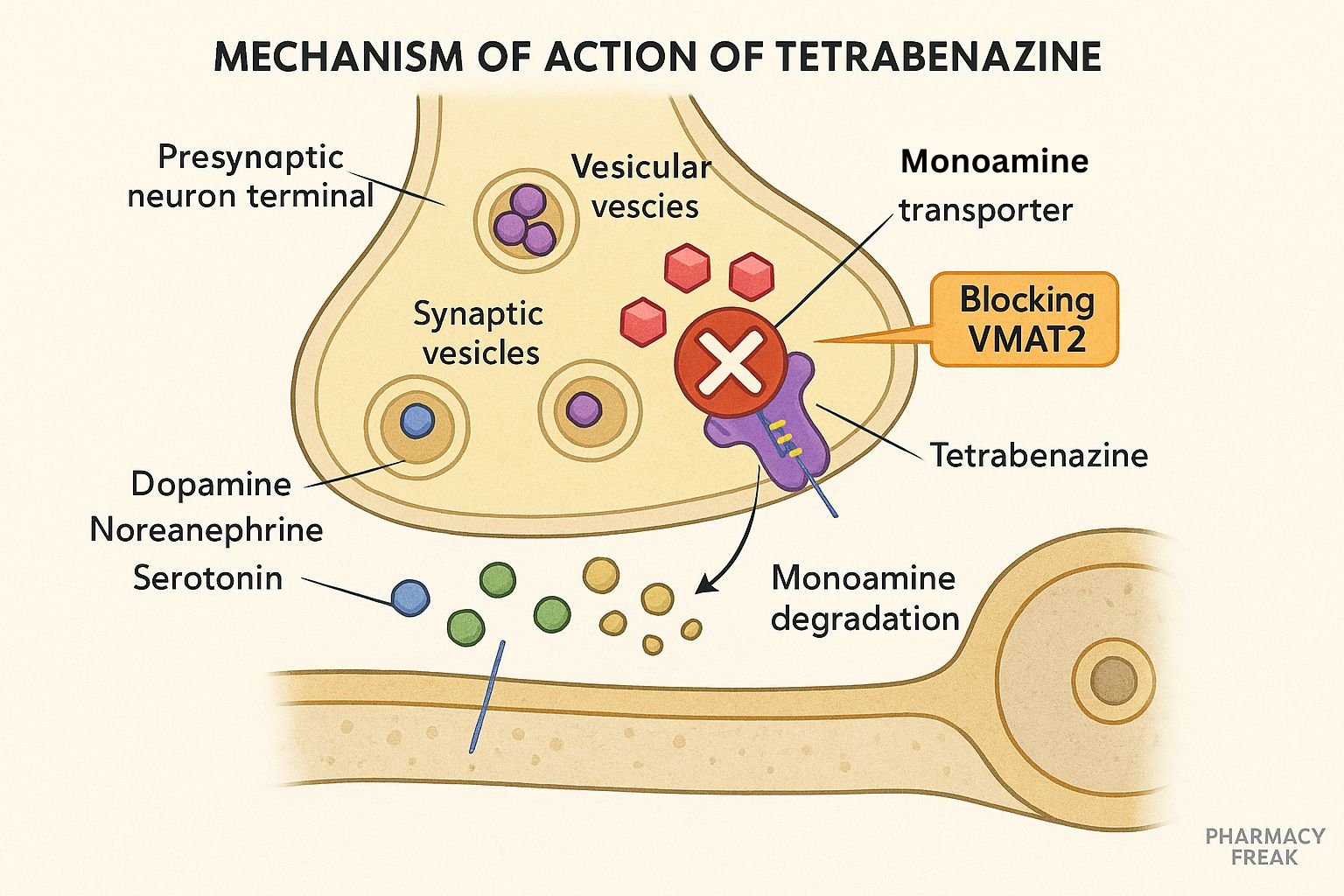Table of Contents
Introduction
Tetrabenazine is a centrally acting vesicular monoamine transporter 2 (VMAT2) inhibitor used primarily to manage hyperkinetic movement disorders. It is especially effective in reducing chorea associated with Huntington’s disease. By depleting monoamines such as dopamine from nerve terminals, it helps in restoring neurochemical balance in the basal ganglia.
Mechanism of Action (Stepwise Points)
- Selective VMAT2 Inhibition: Tetrabenazine binds reversibly to VMAT2 in presynaptic neurons.
- Reduced Monoamine Storage: It prevents dopamine, norepinephrine, and serotonin from entering synaptic vesicles.
- Increased Cytosolic Breakdown: Monoamines remain in the cytoplasm and are degraded by monoamine oxidase (MAO), particularly MAO-B for dopamine.
- Synaptic Dopamine Depletion: The depletion leads to diminished dopaminergic neurotransmission.
- Symptom Relief: Reduced dopamine transmission alleviates chorea and other hyperkinetic movements.




Pharmacokinetics
- Absorption: Rapid oral absorption; bioavailability is low due to first-pass metabolism.
- Metabolism: Extensively metabolized in the liver to active metabolites α-HTBZ and β-HTBZ.
- Half-life: Parent compound ~6 hours; active metabolites ~4–8 hours.
- Excretion: Primarily via urine; minor fecal elimination.
- Protein Binding: Moderate binding to plasma proteins.
Clinical Uses
- Chorea associated with Huntington’s disease
- Tardive dyskinesia
- Tourette syndrome (off-label)
- Hemiballismus (off-label)
Adverse Effects
- Sedation and Fatigue
- Depression and Suicidality
- Parkinsonism (bradykinesia, rigidity)
- Insomnia
- Orthostatic hypotension
- Nausea
Comparative Analysis
| Feature | Tetrabenazine | Deutetrabenazine | Valbenazine |
|---|---|---|---|
| Target | VMAT2 | VMAT2 | VMAT2 |
| Duration of Action | Short | Longer than tetrabenazine | Longest |
| Dosing Frequency | Multiple times/day | Twice daily | Once daily |
| CNS Penetration | High | Moderate | Moderate |
| Approved Indications | Chorea (HD) | Chorea, Tardive dyskinesia | Tardive dyskinesia |
| Side Effects | Depression, sedation | Less depression, sedation | Least CNS effects |
Explanation: Tetrabenazine was the first VMAT2 inhibitor, with high CNS activity but greater psychiatric risks. Deutetrabenazine and valbenazine offer improved pharmacokinetics and tolerability.
Multiple Choice Questions (MCQs)
- Tetrabenazine primarily inhibits which transporter?
a) DAT
b) SERT
c) VMAT2
d) NET - Tetrabenazine leads to reduced levels of which neurotransmitter most significantly?
a) GABA
b) Dopamine
c) Glutamate
d) Acetylcholine - Which disorder is FDA-approved for tetrabenazine use?
a) Parkinson’s disease
b) Epilepsy
c) Huntington’s chorea
d) ALS - What is the major psychiatric side effect of tetrabenazine?
a) Euphoria
b) Mania
c) Depression
d) Hallucinations - Tetrabenazine is metabolized in the liver to:
a) Dopamine
b) α-HTBZ and β-HTBZ
c) Levodopa
d) Serotonin - Which is NOT a common adverse effect of tetrabenazine?
a) Fatigue
b) Seizures
c) Insomnia
d) Parkinsonism - VMAT2 is responsible for transporting monoamines into:
a) Nucleus
b) Synaptic vesicles
c) Axon hillock
d) Mitochondria - Compared to tetrabenazine, deutetrabenazine has:
a) Shorter half-life
b) Fewer side effects
c) Higher toxicity
d) No CNS penetration - Which monoamine is most involved in chorea pathophysiology?
a) Serotonin
b) Dopamine
c) Histamine
d) GABA - What is the route of administration for tetrabenazine?
a) Intramuscular
b) Oral
c) Subcutaneous
d) Intravenous
FAQs
Q1: Can tetrabenazine be used in depression?
A1: No. In fact, it can exacerbate depression and should be used cautiously in such patients.
Q2: Is tetrabenazine a dopamine antagonist?
A2: No. It depletes presynaptic dopamine by inhibiting its vesicular storage, not by receptor antagonism.
Q3: What makes deutetrabenazine safer than tetrabenazine?
A3: Deutetrabenazine has deuterium-substitution, prolonging half-life and reducing peak-trough fluctuations, thereby minimizing side effects.
Q4: Does tetrabenazine require dose titration?
A4: Yes. Dosing should be started low and gradually increased based on response and tolerability.
References
- Goodman & Gilman’s The Pharmacological Basis of Therapeutics, 12th Edition
- KD Tripathi, Essentials of Medical Pharmacology, 7th Edition
- Pharmacological Screening Methods & Toxicology by Avanapu Srinivasa Rao
- Biopharmaceutics & Pharmacokinetics by Thakur Publication
Related Internal Links

I am pursuing MBA in pharmaceutical management from NIPER Hyderabad with a strong academic record and proven success in national-level pharmacy entrance exams. I secured AIR 61 in NIPER 2024 (MS/M.Pharm) and AIR 27 in NIPER MBA, along with AIR 147 in GPAT 2024 and AIR 907 in GPAT 2023. I also achieved AIR 6 in AIIMS CRE-2025 for Drug Store Keeper and was selected as a Pharmacist (AIR 61) for ESIC. Additionally, I was the Runner-Up in Round 2 of the EY Case Study Competition.
At PharmacyFreak.com, I aim to guide future pharmacists through expert content, exam strategies, and insightful resources based on real experience and academic excellence.
Mail- harsh@pharmacyfreak.com
